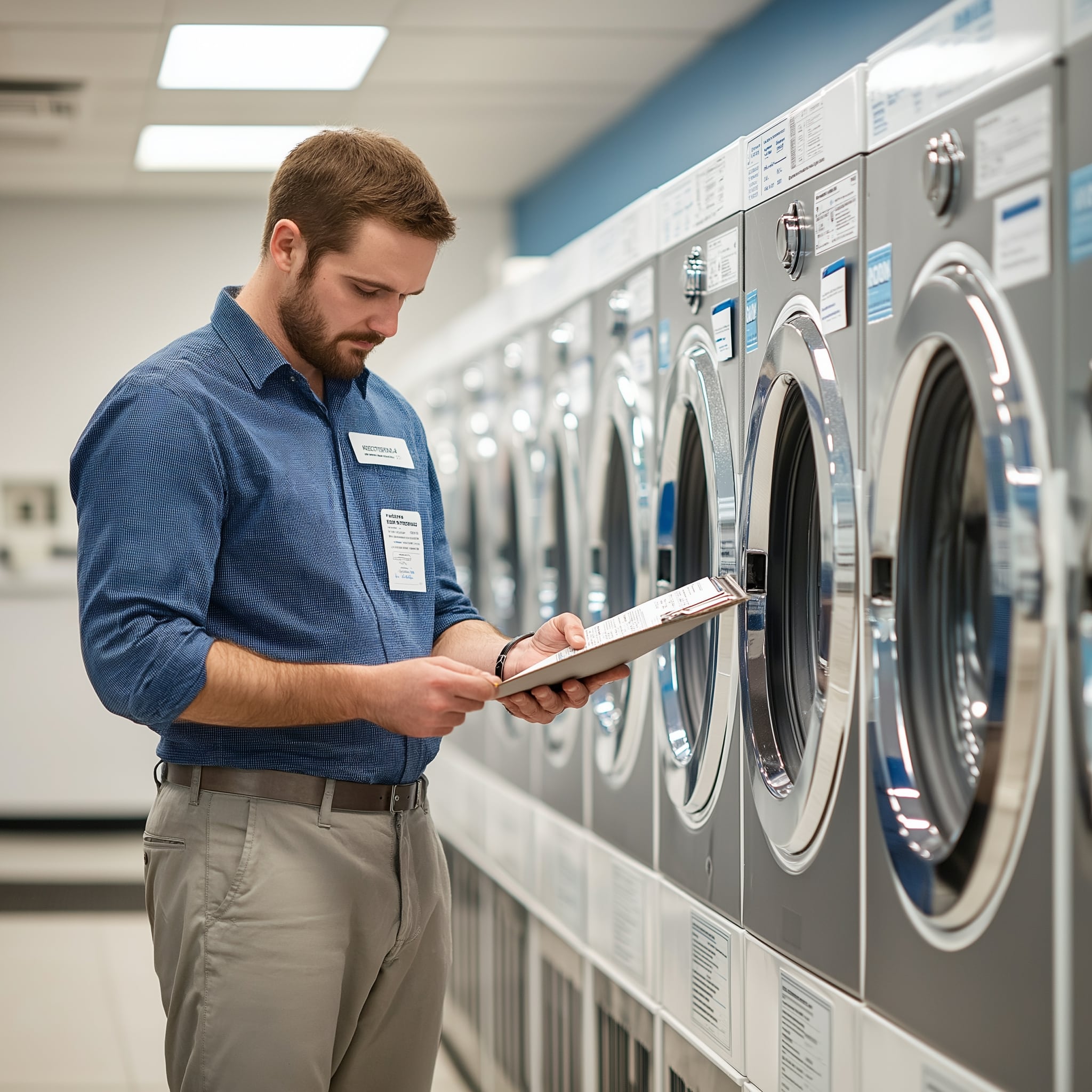If you’re planning to open a laundromat or retool an existing one, one of the most significant considerations is the cost of commercial washers and dryers. These machines are the backbone of your business, and understanding their prices can help you create a realistic budget and make informed decisions. Commercial laundry equipment is a major investment, and it’s essential to balance quality, capacity, efficiency, and price to ensure long-term profitability.
In this article, we will explore the average costs of commercial washers and dryers, the factors that influence those prices, and tips for budgeting for your laundromat retool. By the end, you’ll be well-prepared to make savvy financial decisions for your laundromat business.
1. Understanding the Costs of Commercial Laundry Equipment
Commercial washers and dryers are much more robust and durable than their residential counterparts. They are designed to handle high-volume loads, operate for extended periods, and endure constant use. For this reason, they come with higher price tags, but the investment can pay off with efficiency and longevity.
The average cost of a commercial washer ranges between $1,000 to $5,000 per unit, while commercial dryers typically cost between $1,000 and $6,000 per unit. These figures can vary significantly based on factors such as capacity, energy efficiency, and brand.
For a more detailed breakdown of pricing by machine size, you can explore Coin-O-Matic’s equipment pricing for commercial laundromat equipment.
2. Types of Commercial Washers and Dryers
Before diving into specific price ranges, it’s important to understand the different types of commercial washers and dryers available:
Top-Load vs. Front-Load Washers
- Top-load washers are generally less expensive, with prices ranging from $1,000 to $3,000. They are ideal for smaller laundromats or businesses on a tight budget. However, they may use more water and energy compared to front-load models.
- Front-load washers are more expensive, with costs between $2,000 and $5,000, but they are typically more energy-efficient, use less water, and can handle larger loads, making them a popular choice for laundromats aiming for long-term savings.
Stacked Washer-Dryer Units
Stacked washer-dryer units are a space-saving solution that combines a washer and dryer in a single vertical unit. These are often used in laundromats where space is limited. The average cost for stacked units ranges from $2,500 to $5,000.
High-Capacity Machines
High-capacity machines are designed for laundromats that deal with large volumes of laundry or offer specialty services like washing oversized items (e.g., comforters, rugs). These machines can cost anywhere between $3,000 and $6,000 per washer or dryer.
For insights on different types of commercial laundry machines, Maytag Commercial Laundry offers helpful comparisons and recommendations.
3. Key Factors That Influence the Cost
Several factors contribute to the price variations in commercial washers and dryers. Let’s explore some of the most important ones:
a. Machine Capacity
The capacity of a commercial washer or dryer is measured in pounds and refers to how much laundry the machine can handle per load. Machines with larger capacities are more expensive. Standard capacities for commercial washers and dryers range from 15 lbs. to 100 lbs. or more. For example:
- A 20-lb. washer might cost $1,500 to $3,000, while a 50-lb. washer could be priced between $3,000 and $5,000.
- Larger capacity dryers (50-75 lbs.) can cost upwards of $3,000 to $6,000, depending on the brand and features.
b. Energy Efficiency
Investing in energy-efficient washers and dryers can lead to long-term savings on utility bills. However, energy-efficient models often come with higher upfront costs. For example, an energy-efficient washer may cost $1,000 to $2,000 more than a standard model, but the savings in water and electricity can quickly offset this cost.
For more on how energy efficiency can impact the price and operation of commercial laundry equipment, you can refer to resources from the U.S. Department of Energy’s guide on Energy Efficiency in Commercial Laundries.
c. Brand and Manufacturer
The reputation and quality of the brand also play a role in pricing. Well-known brands like Speed Queen, Maytag, and Electrolux tend to be more expensive but offer superior durability, performance, and customer support. While you may pay a premium upfront, these machines are built to last, which can reduce long-term maintenance and replacement costs.
d. Features and Technology
Machines equipped with advanced features such as automated soap dispensers, digital controls, and smart technology (e.g., remote monitoring, Wi-Fi connectivity) will generally be more expensive. For example, machines with programmable wash cycles and moisture sensors in dryers can cost an additional $500 to $1,000 per unit.
4. Budgeting for a Laundromat Retool
Retooling your laundromat requires careful financial planning. Here’s a breakdown of how to effectively budget for new equipment:
a. Estimate the Number of Machines Needed
The number of machines you need will depend on the size of your laundromat and the demand for services. As a rule of thumb, a small laundromat with 15-20 machines will require an equipment investment of $40,000 to $100,000, depending on the quality and features of the machines.
b. Plan for Installation and Additional Costs
The cost of installation and setup should also be factored into your budget. Depending on the complexity of your setup (e.g., plumbing, gas lines for dryers), installation costs can range from $1,000 to $5,000 per machine. You may also need to budget for ongoing maintenance, parts replacement, and warranties.
c. Financing Options
Many laundromat owners choose to finance their equipment purchases. Leasing is another option, with monthly payments ranging from $100 to $500 per machine, depending on the type and brand. Equipment financing can help preserve cash flow while ensuring you have the best machines available for your business.
For more details on laundromat financing options, check out Laundrylux Leasing and Financing.
5. Pros and Cons of Buying vs. Leasing Equipment
When planning a laundromat retool, you’ll need to decide whether to buy or lease your commercial laundry equipment. Each option has its pros and cons:
Buying Equipment
- Pros:
- Full ownership after purchase
- Potential tax benefits, such as depreciation deductions
- Higher resale value when upgrading
- Cons:
- Higher upfront cost
- Responsible for all maintenance and repairs
Leasing Equipment
- Pros:
- Lower upfront costs
- Easier to upgrade machines at the end of the lease
- Maintenance may be included in the lease agreement
- Cons:
- No ownership equity
- Can be more expensive in the long run due to interest and fees
6. New vs. Used Commercial Washers and Dryers
Another important consideration is whether to buy new or used machines. Both options have benefits, but the decision will depend on your budget and long-term goals.
Buying New Machines
- Pros:
- Latest technology and features
- Manufacturer warranties
- More energy-efficient and reliable
- Cons:
- Higher upfront cost
Buying Used Machines
- Pros:
- Lower cost (sometimes half the price of new machines)
- Immediate availability
- Cons:
- Shorter lifespan
- Limited or no warranty
- Potential for hidden maintenance issues
For those considering used equipment, platforms like Laundry Equipment Direct offer a wide range of second-hand commercial washers and dryers.
7. Maintenance and Long-Term Costs
Even after purchasing commercial washers and dryers, you’ll need to account for ongoing maintenance and repairs. Regular upkeep is essential for keeping your machines running efficiently and minimizing downtime.
- Annual maintenance costs typically range between $500 and $1,500 per machine. Factors like the age of the machine, usage frequency, and the availability of replacement parts can impact these costs.
- It’s also wise to set aside a budget for unexpected repairs, as a broken machine can lead to lost revenue and unhappy customers.
For more information on maintenance costs and recommendations, visit Speed Queen’s Laundry Maintenance Guide.
8. Conclusion: Maximizing Your Investment
Investing in commercial washers and dryers is a significant part of running a successful laundromat, but it’s also an opportunity to build a profitable and efficient business. By understanding the average costs, weighing the pros and cons of buying vs. leasing, and factoring in long-term maintenance, you can make informed decisions that will help you maximize your return on investment.
When budgeting for your laundromat retool, remember to consider factors like machine capacity, energy efficiency, and the reputation of the manufacturer. Whether you choose to buy new, used, or lease your equipment, planning ahead and researching your options will ensure you’re prepared for a successful retool and a thriving laundromat business.


















